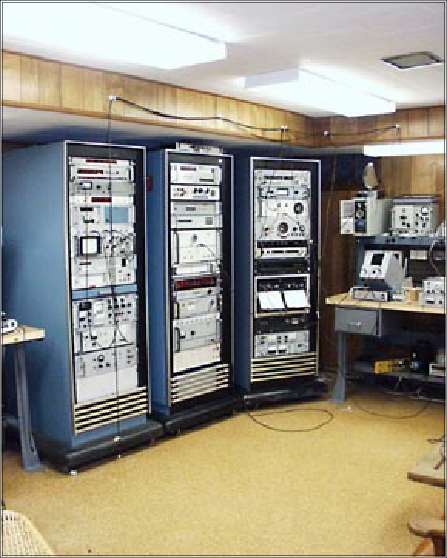
Precision Horology
STANDARDS LAB

A photo of my Standards Laboratory from about 8 or 9 years ago. It’s been much modified since then. When this picture was taken, using satellites for timing purposes was not completely practical. As a result, I had an ensemble of Cesium Beam Frequency Standards as well as large satellite timing receivers and WWVB frequency comparator receivers that I used for timing purposes. Now, of course, the ability of relatively inexpensive timing receivers really take the place of a setup like this. Brian Mumfords Microset Timer with the satellite receiver accessory is all that is really necessary to do precise timing of pendulum clocks.
The instruments in the racks are:
Rack 1: Datum Serial Display Model 9520
Datum GPS Receiver
True Time Model 60DC WWVB Receiver
FTS Model 4030 Cesium Beam Frequency Standard and Clock
HP Model 180 Oscilloscope
Austron Model 2100 Loran-
Tracor Model 2100 Linear Phase Recorder
Fluke Model 207-
Tracor Model 308A Rubidium Frequency Standard
HP Model 107BR Precision Quartz Oscillator
Rack2:Datum GPS Receiver
Austron Model 2110 Disciplined Frequency Standard
HP Rubidium Frequency Standard/Clock
Austron Micro Stepper Model 2055
HP Model 5061A Cesium Beam Frequency Standard
Austron Model 1201 Linear Phase Recorder
Datum Model 9390 Synchronous Generator
HP Model 5065A Rubidium Vapor Frequency Standard
HP Model 106A Precision Quartz Oscillator
HP Model 5065A Rubidium Vapor Frequency Standard
HP Model 106A Precision Quartz Oscillator
Rack 3: HP Model 115BR Frequency Divider and Digital Clock
Tracor Model 895A Linear Phase/Time Comparator
Tracor Model 304D Rubidium Frequency Standard and Clock
HP Model 113BR Frequency Divider and Clock
Arbiter Model 1026 Satellite Controlled Clock
General Radio Synchronometer Type 1123-
Honeywell Electronik Model 195 Chart Recorders
Some of the items in the racks were not really practical to use but were significant in the history of the development of precision timing.